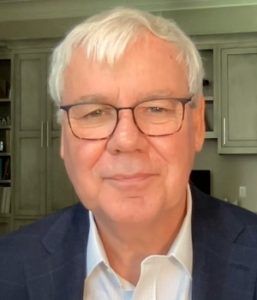Keep it Simple

Today’s post looks at a couple of articles on the simple approach to asset allocation put forward by Jan Loeys.
Jan Loeys

Jan Loeys is a Managing Director at JP Morgan, and he writes regularly about investment strategy.
- Most of his content is for clients only, but the FT has written a couple of articles which provide a flavour of his thinking.
Building a portfolio
Each of the articles is in the FT.
- The first is from September 2023 and looks at how to build an investment portfolio.
Lowes recommends buying only stocks and bonds, describing everything else as “needless complication”.
- That sounds too simple, but let’s find out why he thinks that way.
Loeys doesn’t say how much of your portfolio should go into stocks – that’s a function of:
- your return needs – since stocks return more than bonds
- your ability to withstand short-term drawdowns (stocks are more volatile)
- your need to control long-term risk (not sure what this means)
One could argue that your bond fund should be global, but that would add foreign currency risk that is generally not well compensated.
While it’s true that this portfolio is easy to understand, liquid and cheap to implement and run, the diversification benefits of a two-asset portfolio rely on a low correlation between those two assets.
- As we have seen recently, bonds can be correlated with stocks, and indeed have been for more than half of the last century.
When they are both going down, that’s a problem.
Jan is okay with thematic overlays:
If you have strong views on what asset types, countries, or sectors to have more of than is in these broad funds — say you fancy Technology — you can simply add a Tech ETF.
Since I want relatively equal exposure to the main geographical blocks (rather than a 65% loading to the US) that takes me from two funds to around a dozen (including themes).
It is much easier to execute overweights than underweights. It is harder when there are certain assets you want to have less of, or not have at all — say oil companies. You would need a fund that excludes oil companies, but that may not exist. Then you will have to build a portfolio bottom up by trying to buy all the other sectors.
Luckily for me, I don’t have any exclusions.
He doesn’t believe in “superior assets”:
The Empirical Finance literature has found troves of high-Sharpe ratio assets that have high returns to risk and thus lie above the standard risk-return trade-off line. But it has gradually been dawning on us the last few years that the majority of these show a fading pattern of outperformance, doing well decades ago, but then not doing any better than the broad markets over the past 10 years or so.
Jan thinks that’s because “everybody knows everything”, but I think that it could also be down to special circumstances since the 2008 crash.
- Lots of things haven’t worked since then, because we’ve had historically low interest rates and stock markets dominated by a few very large tech stocks in a single geography (the US).
I’m not convinced that will be the case for the next 15 years (though it’s possible that AI will provide a third wave to follow the impact of the internet and the smartphone).
Not does Jan believe in market timing:
Many of us tend to overrate our ability to call the market short-term. The most successful investors over time tend to be the ones that base their decisions on what they can be quite confident about, which is generally the yield/value of an asset or asset class and its historical long-term relative performance.
The general perception that “retail” tends to buy high, after a market has rallied for some time, and sell low, after that asset class has gone through severe losses, would be consistent with many of usoverrating our trading skills.
The simplest valuation rules , like using an asset class IRR, bond yields and equity yields, or mean reversion in real exchange rates, have had a much better record in judging future long-term returns than more complex systems.
His big message is to keep it simple:
One should not buy assets that are too complex to be easily understood as the risk is then that the asset will not be appropriate for one’s financial objectives.
The fewer the assets one has in one’s portfolio, the easier it is to judge risk on them, the easier it is to gauge one’s exposure, the easier it is to manage one’s portfolio, and the less time it takes.
Time is indeed money. And probably the greatest benefit of simpler products isthat they are cheaper.
This is all true, but we should also remember Einstein:
Everything should be made as simple as possible, but not simpler.
I like to think my portfolio is simple, but I’ve seen the horrified reaction of others when I describe it to them.
One of the key issues Jan doesn’t discuss is tax.
- We have a relatively benign tax regime for investors here in the UK, but it does introduce restrictions on what you can hold and where.
It also introduces a lot of complexity in the form of cash flow management.
- To get the most out of the system, you need to constantly move small amounts of money from one account to another.
Jan believes that “buy and hold” will save on taxes, but that’s only true up to a point – once you reach pension age you need to actively decumulate to minimise tax.
Laws of asset allocation
The second article dates back to November 2017, and introduces eight laws of asset allocation:
- Markets are fairly efficient, so anything that we all know is already in the price.
- This implies that higher returns require taking greater risk
- Asset allocation is the key driver of portfolio returns (I would add costs and taxes to this)
- Be guided by Occam’s Razor, which means that if you can explain the world with one variable, don’t use two.
- The economic regime (“global reflation, central bank policy, deflation risk from an oil price collapse etc.”) is the key driver of trends in asset markets
- This can be quite difficult to determine when one regime is starting to evolve into another
- Pay more attention to changes in the fundamentals than to their levels.
- The most likely (modal) forecast is already built into the consensus, but the most likely outcome is the probability-weighted mean of all possible outcomes, which will be different
- Changes in tail risks can change prices without changing the modal forecast
- Try to forecast the broad direction of asset prices, not their precise future path.
- This is still quite difficult, but also very useful information
- The US is the “indispensable” market, and the rest of the world should be judged via spreads to the US.
- US markets – and economic data – move the rest, and not the other way around
- Expectations are adaptive, not “rational”.
- Investors update their rational beliefs as new evidence comes in
- In effect, market expectations are driven by moving averages of the past
- Be wary of using data on financial flows and investor positions.
- Prices have already shifted to match supply and demand
- Inflows are matched by outflows and overweights by underweights
- Portfolio optimisation can be almost unworkable in the real world.
- Mean-variance optimisation depends on volatilities and correlations that are highly unstable in the short term, and vulnerable to economic shocks
- Which in turn means that the optimal portfolio jumps around
- My fix for this is to use very long-term correlations, returns and volatilities
- Loey’s fix is to add tilts to a balanced core portfolio (which I also do)
Conclusions
It’s been a decent read, but to be honest, I’m slightly disappointed.
- The latest article has been very well-received by the investor community and I was expecting more.
There’s little to disagree with, but little that is actionable.
- Perhaps that’s down to how my portfolio is arranged already.
I came away with the impression that Jan is one of those commentators who writes in such a seductive style that people enjoy reading him so much that they overlook the lack of actionable content.
- Morgan Housel is probably the best example at the moment for the general audience.
He’s a great writer, but you can’t fix your portfolio by buying his book.
- Until next time.















